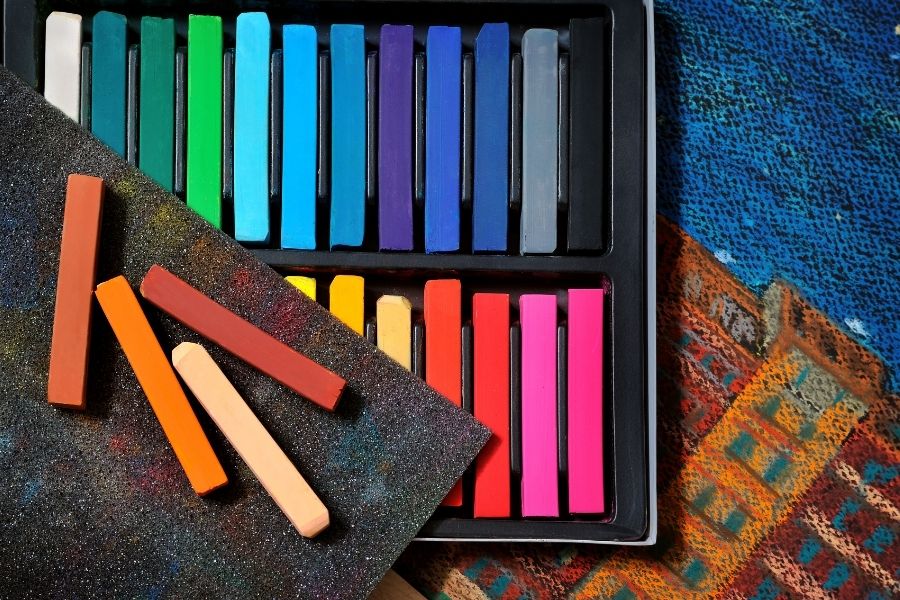Basic Techniques for Pastels

Hello, how are you today? Welcome to our blog About Painting and Art. We hope you are very well and looking forward to a new Free Art and painting Post or Tutorial.
Today we want to share with you a special post:
How do beginners use pastels?
Each of these pastel techniques can be used alone or in combination to produce a pastel painting. There is no right or wrong way. As with so many things in painting, it all comes down to what you like to do with your pastels.
Remember to test each cake technique with different cakes (hard, semi-soft, and soft), as each gives a slightly different result, as do different cake brands.
Draw with the end of a cake
The easiest way to use a cake is to draw with the end, holding it like a pencil or pen. The resulting line has a great expression, conveying an idea of the gesture you made.
Change the thickness of the line by varying the pressure you apply to the cake. The harder you press, the more cake you will deposit on the sheet. For finer lines, press more gently or use the edge.
Tip: Use your entire arm, not just your wrist, as this encourages a looser, wider drawing.
Using the edge of a cake
If you want to work quickly, creating large blocks of color, use the side of a pastel bar. For best results, cut (yes, I said break) a stick in half and use; remember, even the smallest piece of cake can still be used.
Changing the pressure will create different degrees of texture on the pastel paper. When the side of the cake is worn, giving two sharp edges can also be used to create fine lines.
Tip: It is best to use semi-soft or soft pastels.
Scratched and scratched
If you have drawn a drawing, this technique will be familiar to you, it works best with pastel pencils or stiff cake sticks. The plot is simply a set of parallel lines, preferably thin lines (hence the pencil) closely spaced. Cross hatching is just the next step, drawing a second set of lines at an angle (most of the time at right angles to the first set).
This method is especially useful in pastel painting for the initial blockage of a painting. It allows you to experiment with color and tone loosely and flexibly without fully committing to a final composition.
Tip: You can use this method to create a shape print by varying the direction of the screen.
Cake mix
Unlike other mediums, pastels are not mixed before putting on paper. There are two ways to create variations in colors and tones: optical blending, which is achieved by bringing the colors together (see hatching), and blending, where the pastel is blended onto the paper.
You have a wide variety of tools to use for mixing, although the traditional one is the finger (you have to decide if you want to use a surgical glove to protect your hands or not). The hand side is also available, useful for large mixing areas, but not good for accurate results; paper tools such as kinks, tea towels, and paper stumps; putty (or kneaded) gums, rags, and cotton (balls or cocoons).
- Tip 1: If you use your finger (or hand), remember to clean it regularly to avoid contaminating the paint with previously mixed colors. Always have a box of wet wipes on hand, even when painting outdoors.
- Tip 2: Paper stumps and twists can be cleaned for later use by unrolling a layer on the end or by removing the end surface with a sharpener.
Hearty cakes
One of the great advantages of pastels over other mediums is the vibrancy you can get with color. Perhaps the best method to achieve this is by nibbling - after a layer of cake has been applied and set, lightly slide a soft cake to its side on top. This creates a torn blanket of the new color on top.
The result is visually stimulating and highly textured, and a careful choice of colors will produce stunning results.
- Tip: This method works best with softer pastels.
Feathers with pastels
Feathering is a refined form of hatching with short strokes. The result is a bit like a rumble - it can add pizzazz to a painting. Plumage will also work for optical color mixing (as with pointillist paintings) where the eye mixes colors rather than blending them on paper.
Tip: This method is especially suitable for giving the appearance of iridescence to fabrics, feathers, and scales, or for creating atmospheric effects with light.
Sprinkle with cakes
Instead of nagging a cake over an existing color block, try sprinkling it. Hold a cake over the color block (easier if this has been corrected, but not essential) and scrape across the surface of the bar to create dust. Once you are satisfied with the arrangement of the powder on the paper, use a flat spatula to squeeze the powder onto the surface.
- Tip: It's much easier to do this with horizontally held paint - the pastel powder will fall exactly where you want it to and won't contaminate the rest of the image.
- Tip: Make sure the putty knife is really clean before trying this, and even if you move the putty knife a bit it won't mix colors.
Enjoy The Video Tutorial about Soft pastel techniques | Soft pastels for beginners
Source: Jekaterina Kotenikova

Ok, That is all for now…
If you enjoyed this article please, Share and Like our Facebook Page. Thanks.
See you in the next post, Have a Wonderful Day!

You might also enjoy these articles: